Neck turn
- Lay your baby on their back or hold them against your chest.
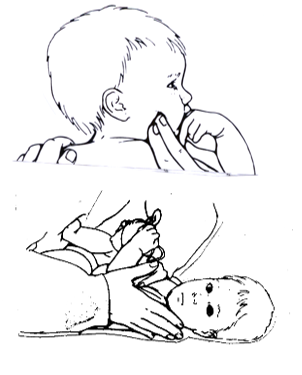
- Have your baby move their eyes and head to follow a toy or your face as far as possible to the right.
- Help your baby turn their head until your baby is looking over the right shoulder. Hold their left shoulder so it doesn’t rise up.
- Hold this stretch for up to _____ seconds.
- Do this stretch ______ times.
- After the stretches, try to get your baby to look actively from left to right without your help.
Note: Use a gentle flat hand instead of fingertips (as shown) to help turn the head or provide pressure at the forehead. Do not press on the jaw. |
Side neck tilt
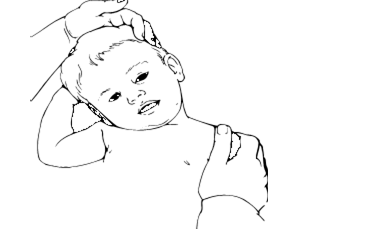 Hold your baby’s right shoulder so it does not rise up. Gently tilt your baby’s head to the left. Move the head so that the left ear moves toward the left shoulder. Make sure the right shoulder does not move when the head moves. Hold this stretch for up to _______ seconds. Do this stretch _____ times. Hold your baby’s right shoulder so it does not rise up. Gently tilt your baby’s head to the left. Move the head so that the left ear moves toward the left shoulder. Make sure the right shoulder does not move when the head moves. Hold this stretch for up to _______ seconds. Do this stretch _____ times.
|
Side tilt carrying position
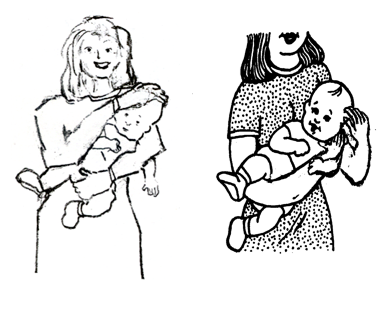 Hold your baby on their right side as your baby faces away from you. One of your arms will be between your baby’s legs. Use your other hand to gently tilt the head to the left by moving your baby’s ear towards the left shoulder. Make sure the right shoulder does not move when the head moves. Hold this stretch for up to _______ seconds, _____ times. You can also carry your baby in this position to work on active tilting to the left. Hold your baby on their right side as your baby faces away from you. One of your arms will be between your baby’s legs. Use your other hand to gently tilt the head to the left by moving your baby’s ear towards the left shoulder. Make sure the right shoulder does not move when the head moves. Hold this stretch for up to _______ seconds, _____ times. You can also carry your baby in this position to work on active tilting to the left.
|
Neck stretch
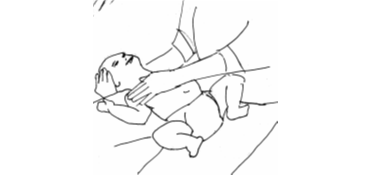 Put your child on their back over your lap with the head supported with your hand. Slowly lower your child’s head, while holding their shoulders down. Use toys or a mirror for distraction. Put your child on their back over your lap with the head supported with your hand. Slowly lower your child’s head, while holding their shoulders down. Use toys or a mirror for distraction.
|
Rolling
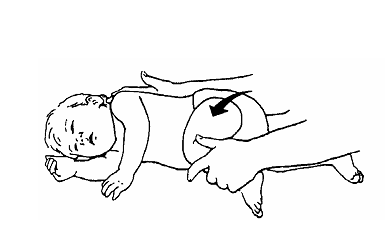 Help your baby roll over on their right side with the right arm stretched up overhead. Look for the head to lift or tilt to the left while rolling. Help your baby roll over on their right side with the right arm stretched up overhead. Look for the head to lift or tilt to the left while rolling.
Help your baby at the hips or have them reach with the opposite arm to start the movement.
|
Tummy time on elbows
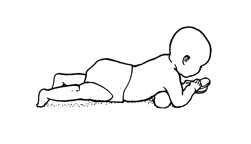 Put your baby on their stomach. Use a towel roll to help prop your child onto the elbows. Be sure to prop equally on both arms. Practice at least three times a day. Have your baby try to look up and to the right side. Put your baby on their stomach. Use a towel roll to help prop your child onto the elbows. Be sure to prop equally on both arms. Practice at least three times a day. Have your baby try to look up and to the right side.
|
Tummy time on straight arms
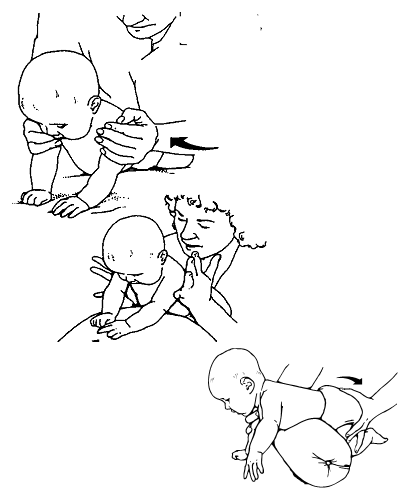 Put your baby on their stomach. Help your baby push up onto straight arms with open palms. Be sure to use both arms equally. Help your baby shift their weight from side to side in this position. Practice at least three times every day. Have your baby try and look up and to the right side. Put your baby on their stomach. Help your baby push up onto straight arms with open palms. Be sure to use both arms equally. Help your baby shift their weight from side to side in this position. Practice at least three times every day. Have your baby try and look up and to the right side.
You can also put your baby over your leg or a firm pillow. Have your baby push up with straight arms. Try to get your baby to look up.
|
Reach to feet
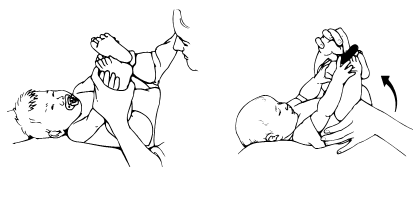 Try to get your baby to reach for their feet while lying on the back. Help by gently bending your baby’s legs and helping touch their feet. Sometimes it is helpful to have your baby reach for a toy, jingle socks or Velcro rattle. Try to get your baby to reach for their feet while lying on the back. Help by gently bending your baby’s legs and helping touch their feet. Sometimes it is helpful to have your baby reach for a toy, jingle socks or Velcro rattle.
|
Pull to sit
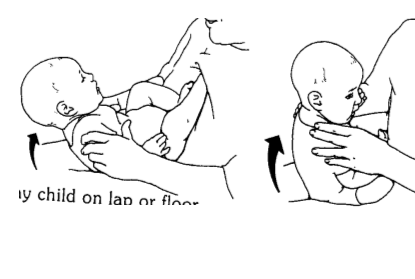 With your baby on their back, put your hands behind their shoulders. Have your baby look up at you with chin tucked. Gently help your baby into a sitting position having them do most of the work. You may also work on moving from sitting back down to back lying. Remember to do this after diaper changes. With your baby on their back, put your hands behind their shoulders. Have your baby look up at you with chin tucked. Gently help your baby into a sitting position having them do most of the work. You may also work on moving from sitting back down to back lying. Remember to do this after diaper changes.
|
High side lying
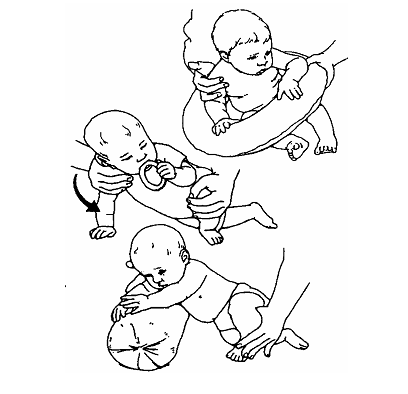 Have your baby sit or lean on their right side bearing weight on the forearm. You want to see a head tilt to the left as your baby reaches forward with the left arm. Have your baby sit or lean on their right side bearing weight on the forearm. You want to see a head tilt to the left as your baby reaches forward with the left arm.
|
Push to sit
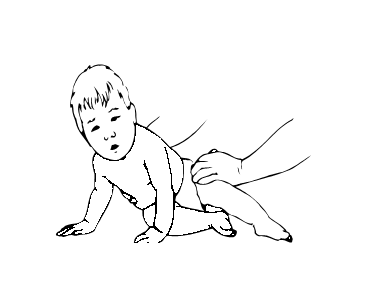 Start with your baby lying on the right side bearing weight on the forearm. Help your baby push up to sitting with your right hand under their trunk. At the same time, give a very gentle push down on the left hip. Let your baby do as much of the work as possible. Look for a head tilt to the left (ear to shoulder). Start with your baby lying on the right side bearing weight on the forearm. Help your baby push up to sitting with your right hand under their trunk. At the same time, give a very gentle push down on the left hip. Let your baby do as much of the work as possible. Look for a head tilt to the left (ear to shoulder). |
Side sit
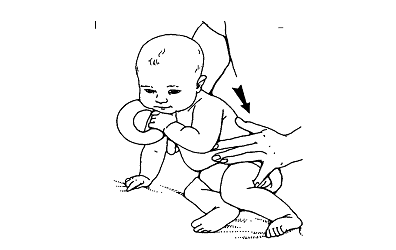 Help your baby side sit to the right bearing weight on the right hand. Look for a midline head position or a tilt to the left and good weight bearing on the arm. Have your baby reach out with the left hand. Help your baby side sit to the right bearing weight on the right hand. Look for a midline head position or a tilt to the left and good weight bearing on the arm. Have your baby reach out with the left hand.
|
Prop sit
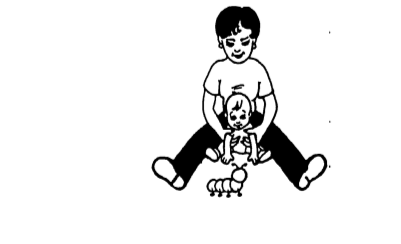 Help your baby bring their arms forward and put weight on the arms in a sitting position with legs extended. Help your baby push up into upright sitting again. Help your baby bring their arms forward and put weight on the arms in a sitting position with legs extended. Help your baby push up into upright sitting again.
|
Midline sitting activities
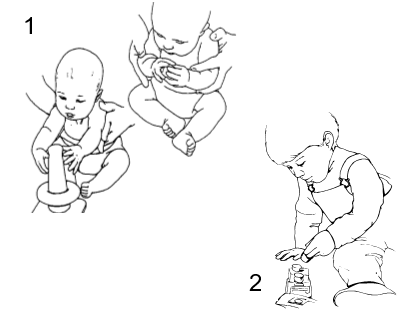 Work on forward reaching with both arms in the middle while sitting. Work on forward reaching with both arms in the middle while sitting.
Work on having your baby reach across the middle of their body with their left hand while the right hand is on the ground/floor.
|
Trunk strengthening
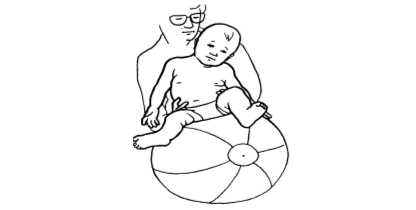 Help your baby strengthen their trunk and neck while sitting. Do this by tilting your baby’s body to the side, forward and backwards in a diagonal pattern. Look for your baby to return to a midline position after you tilt them. Help your baby strengthen their trunk and neck while sitting. Do this by tilting your baby’s body to the side, forward and backwards in a diagonal pattern. Look for your baby to return to a midline position after you tilt them.
|
Carrying
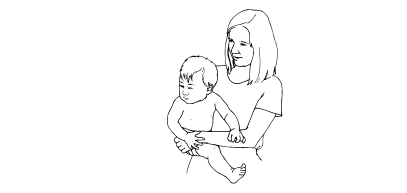 Carry your baby facing out to encourage looking to the right. Carry your baby facing out to encourage looking to the right.
|
Positioning
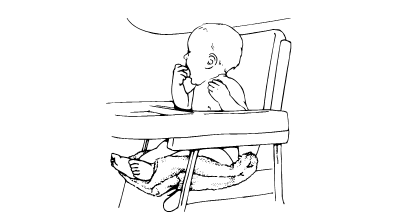 Use a folded washcloth ¼ – ½” thick taped under your baby’s left buttock. Do this when they are sitting on the floor and playing or in a high chair. This will help your baby tilt their head to the left to strengthen the neck muscles in this position. Use a folded washcloth ¼ – ½” thick taped under your baby’s left buttock. Do this when they are sitting on the floor and playing or in a high chair. This will help your baby tilt their head to the left to strengthen the neck muscles in this position.
|
Simple changes that can help your baby’s progress
- Try to get your baby to look to the right by putting the car seat or seat swing so that the activity in the room is to the right of your child.
- Have your child lay on their right side to play.
- When feeding your baby, position you and the baby to encourage head turning to the right. Your baby’s head should not be tilted when feeding.
- When holding your baby upright at your shoulder, hold them on the shoulder that makes your baby look to the right.
- When cradling your baby, you can work on positioning them with their hands and trunk in the middle.
- Use a front carrier to carry your baby.
- Limit the time spent in a bouncy chair or flat on their back and head while awake.
|
 Start with your baby lying on the right side bearing weight on the forearm. Help your baby push up to sitting with your right hand under their trunk. At the same time, give a very gentle push down on the left hip. Let your baby do as much of the work as possible. Look for a head tilt to the left (ear to shoulder).
Start with your baby lying on the right side bearing weight on the forearm. Help your baby push up to sitting with your right hand under their trunk. At the same time, give a very gentle push down on the left hip. Let your baby do as much of the work as possible. Look for a head tilt to the left (ear to shoulder).




 Hold your baby’s right shoulder so it does not rise up. Gently tilt your baby’s head to the left. Move the head so that the left ear moves toward the left shoulder. Make sure the right shoulder does not move when the head moves. Hold this stretch for up to _______ seconds. Do this stretch _____ times.
Hold your baby’s right shoulder so it does not rise up. Gently tilt your baby’s head to the left. Move the head so that the left ear moves toward the left shoulder. Make sure the right shoulder does not move when the head moves. Hold this stretch for up to _______ seconds. Do this stretch _____ times. Hold your baby on their right side as your baby faces away from you. One of your arms will be between your baby’s legs. Use your other hand to gently tilt the head to the left by moving your baby’s ear towards the left shoulder. Make sure the right shoulder does not move when the head moves. Hold this stretch for up to _______ seconds, _____ times. You can also carry your baby in this position to work on active tilting to the left.
Hold your baby on their right side as your baby faces away from you. One of your arms will be between your baby’s legs. Use your other hand to gently tilt the head to the left by moving your baby’s ear towards the left shoulder. Make sure the right shoulder does not move when the head moves. Hold this stretch for up to _______ seconds, _____ times. You can also carry your baby in this position to work on active tilting to the left. Put your child on their back over your lap with the head supported with your hand. Slowly lower your child’s head, while holding their shoulders down. Use toys or a mirror for distraction.
Put your child on their back over your lap with the head supported with your hand. Slowly lower your child’s head, while holding their shoulders down. Use toys or a mirror for distraction. Help your baby roll over on their right side with the right arm stretched up overhead. Look for the head to lift or tilt to the left while rolling.
Help your baby roll over on their right side with the right arm stretched up overhead. Look for the head to lift or tilt to the left while rolling.  Put your baby on their stomach. Use a towel roll to help prop your child onto the elbows. Be sure to prop equally on both arms. Practice at least three times a day. Have your baby try to look up and to the right side.
Put your baby on their stomach. Use a towel roll to help prop your child onto the elbows. Be sure to prop equally on both arms. Practice at least three times a day. Have your baby try to look up and to the right side. Put your baby on their stomach. Help your baby push up onto straight arms with open palms. Be sure to use both arms equally. Help your baby shift their weight from side to side in this position. Practice at least three times every day. Have your baby try and look up and to the right side.
Put your baby on their stomach. Help your baby push up onto straight arms with open palms. Be sure to use both arms equally. Help your baby shift their weight from side to side in this position. Practice at least three times every day. Have your baby try and look up and to the right side. Try to get your baby to reach for their feet while lying on the back. Help by gently bending your baby’s legs and helping touch their feet. Sometimes it is helpful to have your baby reach for a toy, jingle socks or Velcro rattle.
Try to get your baby to reach for their feet while lying on the back. Help by gently bending your baby’s legs and helping touch their feet. Sometimes it is helpful to have your baby reach for a toy, jingle socks or Velcro rattle. With your baby on their back, put your hands behind their shoulders. Have your baby look up at you with chin tucked. Gently help your baby into a sitting position having them do most of the work. You may also work on moving from sitting back down to back lying. Remember to do this after diaper changes.
With your baby on their back, put your hands behind their shoulders. Have your baby look up at you with chin tucked. Gently help your baby into a sitting position having them do most of the work. You may also work on moving from sitting back down to back lying. Remember to do this after diaper changes. Have your baby sit or lean on their right side bearing weight on the forearm. You want to see a head tilt to the left as your baby reaches forward with the left arm.
Have your baby sit or lean on their right side bearing weight on the forearm. You want to see a head tilt to the left as your baby reaches forward with the left arm. Help your baby side sit to the right bearing weight on the right hand. Look for a midline head position or a tilt to the left and good weight bearing on the arm. Have your baby reach out with the left hand.
Help your baby side sit to the right bearing weight on the right hand. Look for a midline head position or a tilt to the left and good weight bearing on the arm. Have your baby reach out with the left hand. Help your baby bring their arms forward and put weight on the arms in a sitting position with legs extended. Help your baby push up into upright sitting again.
Help your baby bring their arms forward and put weight on the arms in a sitting position with legs extended. Help your baby push up into upright sitting again.  Work on forward reaching with both arms in the middle while sitting.
Work on forward reaching with both arms in the middle while sitting.  Help your baby strengthen their trunk and neck while sitting. Do this by tilting your baby’s body to the side, forward and backwards in a diagonal pattern. Look for your baby to return to a midline position after you tilt them.
Help your baby strengthen their trunk and neck while sitting. Do this by tilting your baby’s body to the side, forward and backwards in a diagonal pattern. Look for your baby to return to a midline position after you tilt them.  Carry your baby facing out to encourage looking to the right.
Carry your baby facing out to encourage looking to the right. Use a folded washcloth ¼ – ½” thick taped under your baby’s left buttock. Do this when they are sitting on the floor and playing or in a high chair. This will help your baby tilt their head to the left to strengthen the neck muscles in this position.
Use a folded washcloth ¼ – ½” thick taped under your baby’s left buttock. Do this when they are sitting on the floor and playing or in a high chair. This will help your baby tilt their head to the left to strengthen the neck muscles in this position.